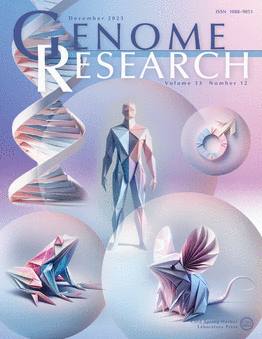系统发育上的亲缘关系而不是水生生境促进了动物中转座因子的水平转移
IF 5.5
2区 生物学
Q1 BIOCHEMISTRY & MOLECULAR BIOLOGY
引用次数: 0
摘要
转座因子(HTT)的水平转移是基因组进化的重要驱动因素,但调节这一现象的因素仍不清楚。在这里,我们筛选了来自四个门(环节动物、节肢动物、软体动物和脊索动物)的247个动物基因组,跨越了水生和陆地生活方式之间的19个独立过渡,以评估水生栖息地和系统发育相关性对HTT的可能的积极影响。在恢复的6043个独立HTT事件中,绝大多数(>85%)涉及DNA转座子,其中水手样和hat样元件具有最高的水平转移率和基因组内扩增率。利用一种新颖的方法,我们发现HTT率与栖息地类型的相似性正相关,但在水生动物中并不明显高于陆生动物。然而,在贝叶斯框架中将HTT事件的数量建模为发散时间的函数,揭示了在大多数研究的动物物种中(247个物种中有162个),系统发育亲缘性对HTT率有明显的积极影响。这种影响是非常明显的:一个典型的物种与它在2.5亿年前分化出来的物种之间的转移,预计是它与650万年前分化出来的物种之间转移的10倍。总的来说,我们的研究强调了HTT在动物中的普遍性以及进化亲缘关系对其动态的影响。本文章由计算机程序翻译,如有差异,请以英文原文为准。
Phylogenetic relatedness rather than aquatic habitat fosters horizontal transfer of transposable elements in animals
Horizontal transfer of transposable elements (HTT) is an important driver of genome evolution, yet the factors conditioning this phenomenon remain poorly characterized. Here, we screen 247 animal genomes from four phyla (annelids, arthropods, mollusks, chordates), spanning 19 independent transitions between aquatic and terrestrial lifestyles, to evaluate the suspected positive effects of aquatic habitat and of phylogenetic relatedness on HTT. Among the 6043 independent HTT events recovered, the vast majority (>85%) involve DNA transposons, of which Mariner-like and hAT-like elements have the highest rates of horizontal transfer and of intragenomic amplification. Using a novel approach that circumvents putative biases linked to phylogenetic inertia and taxon sampling, we find that HTT rates positively correlate with similarity in habitat type but are not significantly higher in aquatic than in terrestrial animals. However, modeling the number of HTT events as a function of divergence time in a Bayesian framework reveals a clear positive effect of phylogenetic relatedness on HTT rates in most of the animal species studied (162 out of 247). The effect is very pronounced: A typical species is expected to show 10 times more transfers with a species it diverged from 250 million years (My) ago than with a species it diverged from 650 My ago. Overall, our study underscores the pervasiveness of HTT throughout animals and the impact of evolutionary relatedness on its dynamics.
求助全文
通过发布文献求助,成功后即可免费获取论文全文。
去求助
来源期刊

Genome research
生物-生化与分子生物学
CiteScore
12.40
自引率
1.40%
发文量
140
审稿时长
6 months
期刊介绍:
Launched in 1995, Genome Research is an international, continuously published, peer-reviewed journal that focuses on research that provides novel insights into the genome biology of all organisms, including advances in genomic medicine.
Among the topics considered by the journal are genome structure and function, comparative genomics, molecular evolution, genome-scale quantitative and population genetics, proteomics, epigenomics, and systems biology. The journal also features exciting gene discoveries and reports of cutting-edge computational biology and high-throughput methodologies.
New data in these areas are published as research papers, or methods and resource reports that provide novel information on technologies or tools that will be of interest to a broad readership. Complete data sets are presented electronically on the journal''s web site where appropriate. The journal also provides Reviews, Perspectives, and Insight/Outlook articles, which present commentary on the latest advances published both here and elsewhere, placing such progress in its broader biological context.
 求助内容:
求助内容: 应助结果提醒方式:
应助结果提醒方式:


